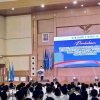Author: Dini Mulyani, Undergraduate Student in Islamic Education Management, Faculty of Tarbiyah and Teacher Training, Sunan Gunung Djati State Islamic University, Bandung / VD
The phenomenon of increasing data complexity due to technological advances demands more accurate and reliable scientific research. However, many studies fail to produce valid findings due to a weak understanding of the concepts of validity and reliability. The assumption that research instruments are always correct often overlooks the reliability and accuracy of measuring tools. The main gap lies in the lack of ability to assess the extent to which instruments measure the intended concept and produce consistent data. Therefore, this article aims to discuss how to systematically build validity and reliability in quantitative and qualitative research methodologies.
First: Data and variables are the foundation of scientific research. Quantitative data takes the form of numbers that can be tested statistically, while qualitative data takes the form of narratives that explain the meaning of social phenomena. Research variables are divided into independent, dependent, moderating, and mediating variables. Understanding the characteristics of variables helps researchers determine cause-and-effect relationships accurately. In this context, validity and reliability not only measure data but also ensure that the variables being studied truly represent the intended phenomenon. Thus, the research becomes objective, measurable, and meaningful.
Second: The population includes all elements being studied, while the sample is a representative portion of that population. The validity of the research depends heavily on how the sample is selected and the data collection instruments used. Improper sampling techniques can cause bias and reduce the reliability of the results. Instruments such as questionnaires, interviews, observations, tests, and documents serve as the main tools for data collection. To be valid, each instrument must be tested through trials and expert judgment to ensure that all aspects of the indicators are measured accurately and consistently.
Third: In a quantitative approach, data is collected through questionnaires, tests, and documentation; while a qualitative approach uses interviews, participatory observation, and document analysis. Strategies to ensure data accuracy include triangulation, instrument testing, enumerator training, and systematic documentation. Triangulation helps test the consistency between data from various sources, while testing ensures that instruments do not give rise to multiple interpretations. Thus, the data collected is not only accurate but also highly consistent as a basis for reliable scientific analysis.
Fourth: Validity and reliability play an important role in the data analysis stage. In quantitative research, validity is tested through statistical analysis such as correlation or regression, while reliability is tested using Cronbach's Alpha or test-retest techniques. In qualitative research, the concepts of credibility, transferability, dependability, and confirmability are used to replace conventional validity and reliability. Researchers must be able to interpret results honestly and transparently so that findings do not deviate from reality. Valid analysis ensures that research results are useful in evidence-based policy and social innovation.
Validity and reliability are not merely technical aspects, but the foundation of scientific integrity in research. Valid instruments ensure relevance, while reliable instruments ensure consistency. Both are key pillars of credible quantitative and qualitative research. When researchers are able to combine measurement accuracy with analytical rigor, research results not only describe phenomena objectively, but also make a real contribution to the development of science and data-based public policy.
*) This article is a review of Part 6 (METHODOLOGY AND TECHNIQUES OF QUANTITATIVE AND QUALITATIVE RESEARCH) from the teaching materials for the Management Research Methods course, taught by Prof. Dr. H. A Rusdiana, M.M. (https://digilib.uinsgd.ac.id/id/eprint/121673)

Follow Instagram @kompasianacom juga Tiktok @kompasiana biar nggak ketinggalan event seru komunitas dan tips dapat cuan dari Kompasiana. Baca juga cerita inspiratif langsung dari smartphone kamu dengan bergabung di WhatsApp Channel Kompasiana di SINI








